Lighting in the bathroom - options and features of wiring
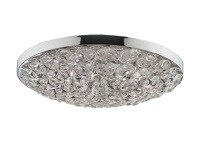
Few people know that the warranty period of operation of electrical wiring is no more than twenty years. Its safety in the house must be given special attention, because electricity is not to be trifled with. If you live in an old house built back in the 1960s-80s, replacing your electrical wiring is not a precaution, but a forced measure, because it is simply not designed to work with modern power.
Washing machines, refrigerators, televisions, air conditioners and other appliances in the house can have a capacity of up to 10 kW, while in the design of the house the standard calculation was made for a capacity of 1.5 kW. Such an excess leads to wear and tear on the insulation, which in turn can cause short circuits and fires.
Especially relevant is the problem of changing the wiring in the bathroom, where the situation is worsened by the high humidity in the room. In this article, we will talk about how to properly plan and implement the wiring and what nuances should be taken into account when choosing lighting fixtures for the bathroom.
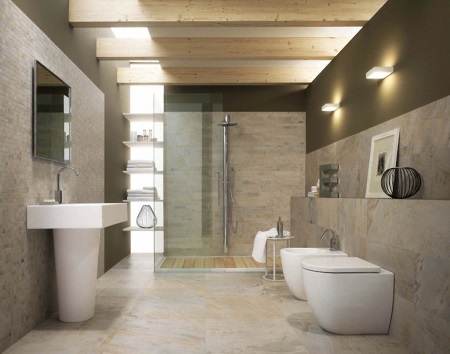
Features of electrical wiring in the bathroom
As we mentioned above, wiring mistakes and damage to the wiring can have the saddest consequences in the future. The first thing to consider when planning your bathroom wiring is careful insulation of all wires. In no case should the exposed areas of the electrical circuit be allowed to get wet. In order not to run the risk of getting an electric shock or ruining all the wiring in the bathroom as a result of the slightest damage, for example, if the insulation on the mains cord of the washing machine is broken, it is recommended to install additional protective disconnection devices (RCD).
RCDs automatically react to any unplanned changes in the electricity supply and immediately open the entire electrical circuit in the event of a current leak.
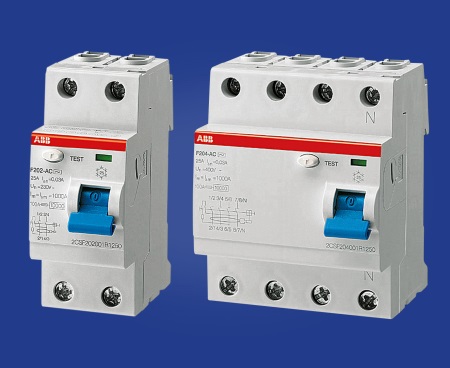
Even with the highest quality and most waterproof fixtures, they should not be placed near water taps, showers or bathtubs. The distance between them should be at least two meters.
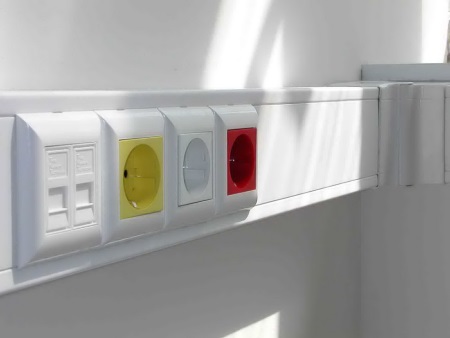
When planning the wiring in the bathroom, remember that the wires for outlets, lighting and electrical appliances must be mounted and connected separately from each other.
In addition, it is necessary to observe safety precautions when working with electrical wires.
To work you will need:
- A voltmeter or multimeter;
- pliers with insulating handles;
- screwdriver with an insulating handle;
- duct tape.
Planning the lighting
When wiring, it is extremely important to think ahead about where your appliances and fixtures will be located. It is necessary to think about the location of switches, outlets, sconces, lamps and chandeliers. This is to avoid having to pull new wires or rewire the existing wiring for each new fixture. The fewer twists and branches the more reliable the network will be.
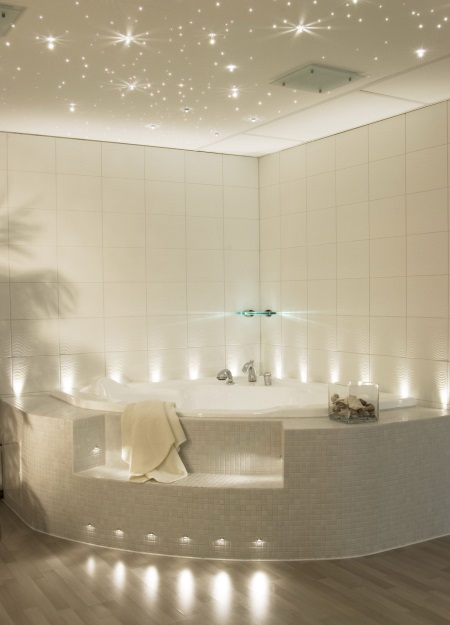
Decide in advance on the option of placing lighting in the bathroom, with the type of lamps and fixtures.
Options
Previously, for some reason preferred to save on bathroom fixtures, and it was accepted to be limited to one lamp under the ceiling or on the wall, above the entrance. Meanwhile, for many people water treatment is a whole ritual. While taking a bath one wants everything around to look calm and harmonious. At the same time, with a visit to the bathroom every morning begins, and to feel comfortable in it, it is necessary to think out everything to the smallest detail.
The most common types of bathroom lighting:
Ceiling lighting - A classic that never gets old. In stores now you can find a wide range of the most diverse lights of different sizes, colors and the most bizarre shapes.
From the ceiling lamp light scatters throughout the room. The main factor in favor of choosing ceiling lighting is the ease of mounting such lamps.
The second most popular type of lighting - spotlights. Unlike wall lights, they do not illuminate the whole room, but only its separate zones or certain elements.
With their help, it is convenient to emphasize the design solutions implemented in your bathroom, as well as to perform a kind of zoning with light.
The popularity of spotlights grew with the spread of fashion for suspended and stretch ceilings. Spot lights do not take up much space and they are convenient to mount in the space behind the ceiling.
Floor lighting - A rare and rather ineffective way of lighting the living space. It is mainly used as an original design move.
For decorative purposes, it can be used to create interesting patterns and ornaments light, as well as for zoning.
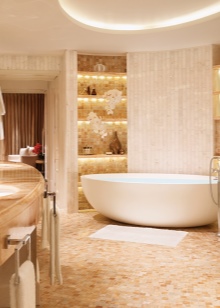
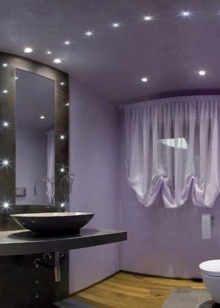
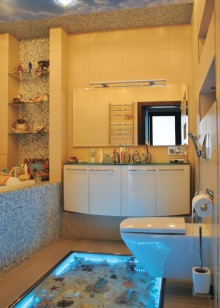
- LED lighting, although also often a design move, is much more functional. It can be used as an independent source of light and as a decorative addition to other lighting fixtures. Now many people choose LED lighting fixtures because of their greater safety and cost-effectiveness compared to other types of lighting fixtures.
Lighting in the bathroom by type of purpose can be divided into three groups: general, zoning and decorative.
You can install separate local lighting, such as above the bathroom mirror, which usually involves the use of special moisture-resistant fixtures.

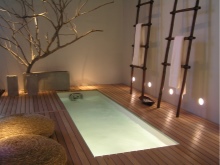
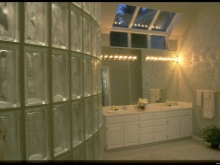
General lighting
Means using, as a rule, only one light fixture.
This option is suitable for those whose bathroom has a small area, if it does not have partitions or any large objects such as showers, which could interfere with an even distribution of light.
The simplest example of a ceiling light is a regular plafond that is screwed into the middle of the ceiling and has a streamlined, sealed shape.
Another ceiling light option is lamps that are mounted in the ceiling. They are convenient to use with suspended or stretch ceilings. In any bathroom, such lamps look harmonious and aesthetic.
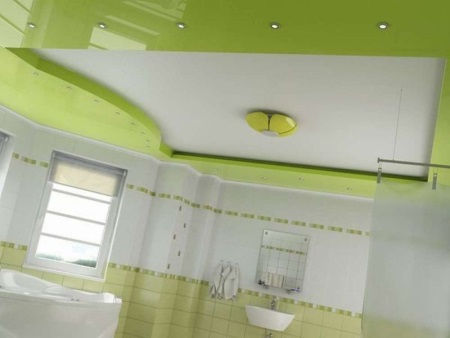
Chandeliers .
The use of chandeliers Is suitable only for those who have high enough ceilings in the bathroom. Otherwise, its use will not only not give the necessary amount of light, but also will not fit into the bathroom interior.
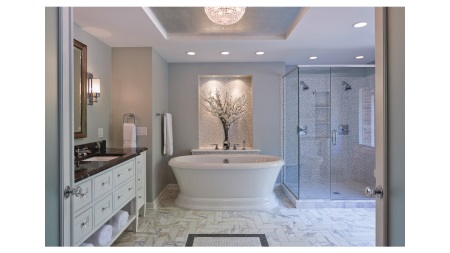
In a spacious bathroom it will become a highlight of the interior, will give charm and uniqueness. When buying a chandelier, be sure to buy one that is in harmony with the design of the entire bathroom.
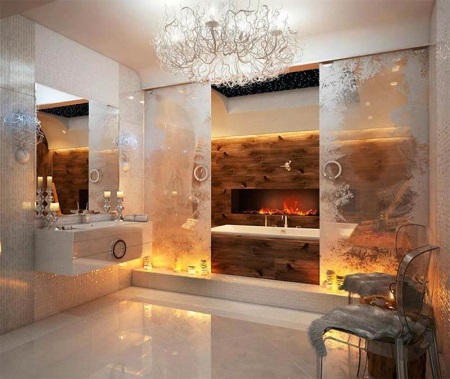
There are also interesting design models that will appeal to lovers of non-standard accessories. If your bathroom has a marine theme, a jellyfish chandelier will look original.
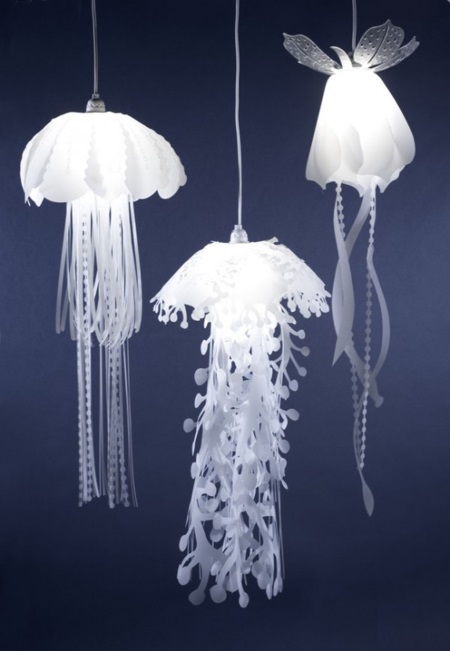
Zone lighting - sconces, lamps
If you need more light, you can install zone lighting and put a wall sconce or any other light fixture where you want to have more light. Using sconces in the bathroom is handyYou can put them where you want more light, and it is good to use wall lamps in the bathroom, because you do not always need extra light.

Lights in the bathroom can be both conventional and spotlighting. Before buying, be sure to think about the design of the ceiling. Perhaps you will need to install light fixtures in the ceiling and that will be enough?
Wall lights, placed on the mirror will also be appropriate, will add light, functionality and zest to the interior.
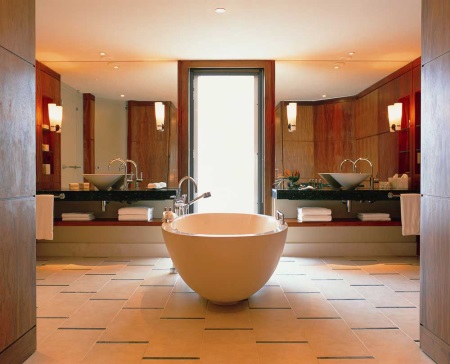
LED strips
Lighting LED lamps, and although not as effective, but very effective. Increase their effectiveness by using a large number of mirrored surfaces.
For the bathroom, choose LED strips with a degree of protection against moisture IP 65.

Types of lamps
Four main types of lamps are used in bathroom fixtures, as well as in any other lighting fixtures:
- incandescent bulbs - the oldest type of lamps, 40-100 W;
- fluorescent . - 7-8 times more efficient than incandescent, but with 8-80 W;
- halogen are nearly twice as bright as ordinary incandescent bulbs, and, thanks to a huge variety of shapes, sizes and designs, they are mainly used for decorative purposes;
- LED are characterized by a very low power consumption with an average wattage of 1 to 7 watts. They are also mostly used for decorative purposes.
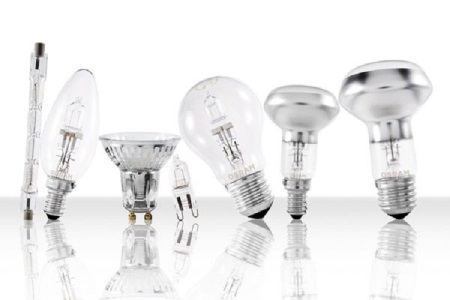
Calculation of the required power
Once you have decided on the desired type of lighting, fixtures and lamps, it is necessary to make preliminary calculations on what the total power of the lamps used should be, so that the room was not dark.
Calculations should be made based on the type of room: whether the room has a cube shape or a parallelepiped. In addition, the tone and color of the finishes, the presence of mirrors and the uniformity of future lighting should be taken into account.
So, for example, for a square-shaped bathroom with a light finish, with a mirror and with even lighting, the required power per square meter will be 42 watts when using incandescent bulbs, and 13 watts for fluorescent bulbs.
If the bath is 3.5 m .2If the bathtub is approx. 3.5 m, then the light power required to light the room is 147 W for incandescent lamps and 45.5 W for fluorescent lamps. For incandescent lamps, depending on operating conditions, this value can range from 42 to 140 W per 1 m2and for fluorescent lamps from 13 to 42 W per 1 m2.
There are more complicated formulas. But if you are anxious to calculate everything very accurately, it will be easier for you to use special programs.
Nuances of wiring
- When conducting wiring, try to immediately provide for all the important points and do not move the wiring from place to place several times - on aluminum wires from deformation appear microcracks that reduce its service life.
- Do not skimp on wiring. This applies not only to the wires themselves, but also to switches, sockets, tubes for wires and other accessories. The quality of the materials you use is directly related to your safety. It is not necessary to buy expensive gold-plated elements, but you should not buy products made of cheap Chinese plastic either.
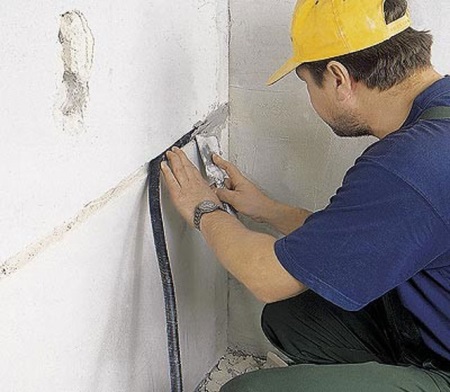
- If you've started a major renovation of your bathroom, remember that you should replace the wiring before any plastering or painting work.
- Also remember that sooner or later, if not you, then your children will have to change the wiring again. Therefore, it is not necessary to embed it into the wall.
In the bathroom, you should only install electrical wiring of the concealed type with double insulation.
How to add a highlight?
If you want to make your bathroom special and bring some new solutions to the issue of bathroom lighting, try to buy LED candles. These are a great alternative to real candles, they will also create a cozy and romantic vibe, but they are much less fussy.
You can try playing with the light by buying a spotlight with a narrow beam of light and directing it to a specific piece of furniture, sink, etc.
Also very convenient and at the same time spectacular is the illumination of shelves for toiletries.
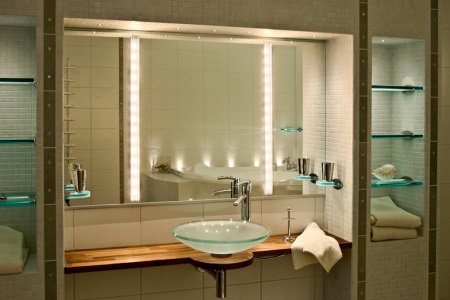
Other light sources
Do not forget about the natural lighting of the bathroom. If you have a window in the bathroom, make it big. Small windows for ventilation are no longer relevant. A window will help to save not only on energy bills, and it will be much easier for you to ventilate the room. For the bathroom, this is especially relevant because of the high humidity. The view from the window on the nature will additionally help you relax.
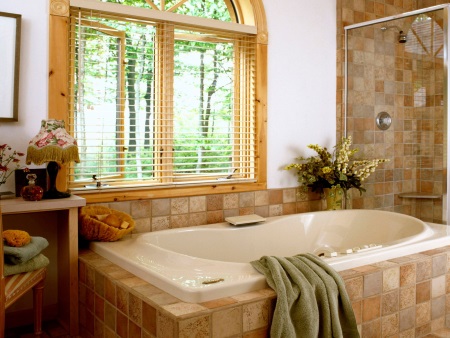
Glass made with the latest technology "smart glass" or smart film PDLC is ideal for the bathroom.. Thanks to this technology, at the touch of a button your glass can change from completely transparent to opaque-white and vice versa. This technology is still often used in meeting rooms.





I think it is necessary to make LED lighting in the bathroom. It's nice to take a bath like that.